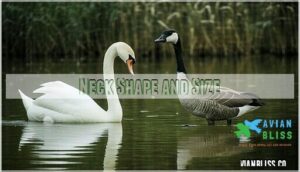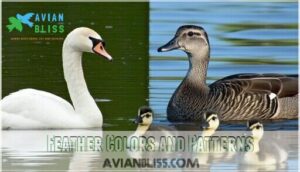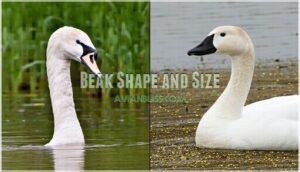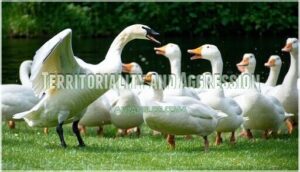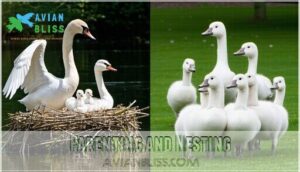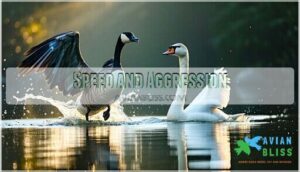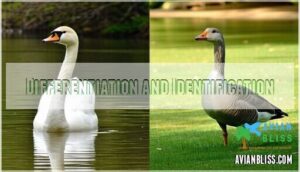This site is supported by our readers. We may earn a commission, at no cost to you, if you purchase through links.
 You’ll spot the swan vs goose difference immediately once you know what to look for.
You’ll spot the swan vs goose difference immediately once you know what to look for.
Swans are larger with elegant S-shaped necks, pure white or black plumage, and can reach 30 pounds.
They’re territorial loners who mate for life.
Geese are smaller, stockier birds with shorter necks, mixed brown-gray coloring, and typically weigh 8-14 pounds.
They’re social creatures that travel in flocks and create those iconic V-formations overhead.
Swans prefer quiet lakes while geese adapt to various wetlands.
Both have webbed feet and belong to the same family, but their temperaments couldn’t be more different.
The real surprises come when you discover their unique survival strategies.
Table Of Contents
- Key Takeaways
- Physical Characteristics
- Behavioral Differences
- Habitat and Migration
- Dietary Preferences
- Speed and Aggression
- Conservation and Threats
- Differentiation and Identification
- Frequently Asked Questions (FAQs)
- What is the difference between a swan and a goose?
- Is a geese a swan?
- What is the difference between a swan and a geese Bill?
- Are Swans better than geese?
- How do you tell a swan from a goose?
- Is a swan a juvenile Goose?
- What is the difference between goose and swan?
- Is a Canadian goose a swan?
- Is swan a goose or crane?
- Can a goose and a swan breed?
- Conclusion
Key Takeaways
- You’ll spot swans by their impressive size and elegant S-shaped necks – they’re much larger than geese (20-30 pounds vs 5-14 pounds) and have distinctively curved necks that stretch nearly two-thirds of their body length
- You can distinguish them by their social behavior and communication styles – swans are territorial loners who mate for life and communicate with soft trumpeting sounds, while geese are highly social flock animals that constantly honk for coordination
- You’ll notice different plumage patterns and habitat preferences – swans typically display pure white or solid black feathers and prefer quiet, deeper lakes, while geese show mixed brown-gray coloring and adapt to various wetlands and grasslands
- You’ll observe contrasting feeding strategies and movement patterns – swans use their long necks to dive deep for aquatic vegetation and fly in small family groups, while geese graze on land with their shorter necks and migrate in large V-formations
Physical Characteristics
When you spot these birds from a distance, their physical differences become immediately apparent and help you tell them apart.
Swans tower over geese with their impressive size, distinctive S-curved necks, and typically all-white or black plumage.
While geese display shorter, straighter necks and more varied coloring patterns.
Neck Shape and Size
You’ll immediately notice the distinctive neck difference when comparing these waterfowl.
Swans possess elegant, S-shaped necks that curve gracefully, measuring up to 1.5 times their body length with enhanced neck vertebrae for feeding adaptation.
Geese display shorter, straighter necks with thicker neck musculature, providing better structural support for terrestrial grazing.
This neck flexibility gives swans superior underwater reach for aquatic vegetation.
Feather Colors and Patterns
You’ll notice striking plumage differences when comparing swan vs goose coloration.
Swans typically display pristine white or solid black feathers, while geese showcase varied brown, gray, and white patterns that provide excellent camouflage.
Male wood ducks exhibit stunning color iridescence during breeding season, unlike swans’ consistent colors.
Juvenile plumage differs markedly between species, with young geese showing mottled bird markings before developing adult feather molting patterns and regional variations.
Beak Shape and Size
You’ll spot striking differences in beak morphology between swans and geese that reflect their feeding adaptations.
Swan beaks are curved, broad, and flat – perfect for aquatic foraging of underwater vegetation.
Goose beaks are triangular, shorter, and stronger, designed for grazing grasses and seeds on land.
This beak evolution shows how bill strength varies based on each species’ dietary needs.
Webbed Feet and Leg Structure
Both swans and geese have webbed feet, but you’ll notice swans’ feet are larger with greater webbing surface area for powerful aquatic locomotion.
Their leg bone density supports their heavier bodies, while geese have smaller, more compact feet better suited for terrestrial movement.
This foot morphology difference reflects their habitat preferences – swans spend more time swimming through aquatic vegetation.
Body Size and Weight
You’ll notice the most striking size comparison between these large birds immediately.
Swans dwarf geese in every measurement, with weight variation ranging from 15-35 pounds compared to geese’s modest 5-14 pounds.
This size advantage affects their body proportions substantially.
Understanding a bird’s general shape and size is vital for identification.
Growth factors determine that swan size requires deeper water for takeoff, while goose size allows greater terrestrial mobility in varied environments.
Behavioral Differences
You’ll notice striking differences in how swans and geese interact with their world and each other.
While swans prefer solitude with their mates, geese thrive in large, chattering flocks that work together like feathered communities.
Social Structure and Flocking
You’ll notice swans prefer solitude while geese embrace social living.
Geese form massive flocks with complex flock hierarchy and cooperative breeding systems, sharing parental duties through group defense mechanisms.
Their social communication involves constant honking and coordinated movements. Swan behavior favors small family units, typically just mated pairs with offspring, showing minimal cooperative tendencies compared to highly social, cooperative goose behavior patterns.
Mating and Pair Bonding
You’ll find striking differences in how these waterfowl approach romance and partnerships.
Both species demonstrate remarkable monogamous tendencies, but their commitment levels vary substantially.
Here’s how their mating strategies differ:
- Lifelong fidelity: Swan behavior showcases stronger pair bond strength, with most species maintaining partnerships until death
- Mate switching: Goose behavior allows occasional partner changes, especially after losing a mate to predators or disease
- Communal defense: Geese rely on flock protection during mating season, while swans depend solely on their partner
Understanding these monogamous patterns helps you distinguish between species during breeding season observations.
Territoriality and Aggression
In terms of territorial behavior, you’ll notice swans act like strict property owners while geese prefer community living.
Swans guard their territory like fortress owners, while geese embrace communal living with neighbors.
Swan territoriality reaches peak intensity during breeding season, with aggressive threat displays including wing-flapping and hissing. Goose aggression appears more defensive than territorial, focusing on flock protection rather than space control.
To manage this, consider implementing effective swan control.
| Aspect | Swans | Geese |
|---|---|---|
| Territory Size | Large, exclusive areas | Shared communal spaces |
| Defense Tactics | Wing beats, charging | Group mobbing, honking |
| Threat Displays | Neck arching, hissing | Head bobbing, loud calls |
| Conflict Resolution | Direct confrontation | Flock coordination |
Communication and Vocalization
Beyond their territorial nature, you’ll notice dramatic differences in how these birds communicate.
Swans produce soft, trumpeting calls and musical notes, while geese create loud, frequent honking sounds.
Geese use varied vocalization types for coordination and alarm calls, whereas swans rely more on silent communication through body language.
- Gentle swan calls create peaceful lakeside moments that soothe your soul
- Loud goose honking cuts through morning silence, announcing their presence boldly
- Silent swan communication through graceful neck movements speaks without words
- Urgent goose alarm calls pierce the air when danger threatens their flock
Parenting and Nesting
While their calls may differ, you’ll notice even bigger contrasts in how these birds approach parenting.
Swans build impressive nests near water and engage in extended incubation periods, with both parents fiercely defending their territory.
Swans require specific materials for nest building to guarantee a safe environment for their young.
Their cygnets stay close for months, receiving dedicated parental care.
Geese prefer ground nests and practice cooperative brood rearing, where multiple families share gosling supervision duties for enhanced protection and survival, which is a unique form of family cooperation.
Habitat and Migration
You’ll discover that swans and geese choose dramatically different places to call home, with swans preferring secluded lakes and deep water while geese thrive in open grasslands near shallow wetlands.
Their migration patterns also differ substantially, as geese form massive flocks traveling thousands of miles along established flyways, while swans typically migrate in smaller family groups over shorter distances.
Preferred Water Bodies and Landscapes
You’ll spot swans gracefully gliding across lakes, ponds, and slow-moving rivers where aquatic vegetation thrives beneath open water.
Meanwhile, geese prefer wetlands and grassy areas near water bodies, perfectly suited for terrestrial grazing.
Swan habitat centers on deeper waters, while goose habitat includes marshes, meadows, and even urban parks.
Habitat loss affects both species differently based on these preferences.
Migration Patterns and Routes
Beyond where these magnificent birds choose to live, you’ll discover fascinating differences in how swans and geese navigate their epic journeys across continents.
Swans follow transcontinental corridors, covering up to 4,000km annually with precise fidelity to established routes. Geese utilize major flyways like North America’s Pacific, Central, and Atlantic routes, spanning 5,000km per season in their signature V-shaped formations.
Understanding these routes is essential for conservation due to habitat destruction impacts.
Key Migration Differences:
- Timing triggers: Swans migrate later, responding to ice formation; geese follow weather fronts and food depletion
- Flight patterns: Swans fly in extended lines at 2,000-8,000ft; geese maintain aerodynamic V-formations at 3,000-9,000ft
- Navigation methods: Swans rely on topographical memory and inherited cues; geese use solar, stellar, and magnetic compass systems
- Stopover ecology: Swans revisit exact wetlands within 5km; geese flexibly adapt routes, increasingly using agricultural staging areas
Climate impacts have shifted both species’ ranges northward over 50 years, with flyway conservation efforts establishing 350+ sanctuaries to support their incredible journeys.
Adaptation to Human-Altered Environments
You’ll notice both swan and goose species thriving in Urban Habitats like city parks and golf courses.
Geese show remarkable adaptability to agricultural areas, often causing Agricultural Impact by grazing crops.
Park Adaptations include using artificial ponds and accepting human feeding.
However, Pollution Effects can reduce water quality in their habitats.
Human Interaction varies – geese tolerate crowds while swans maintain distance despite grasslands encroachment.
Seasonal Movement and Distribution
You’ll notice different seasonal movement patterns when comparing these birds.
Migration triggers vary substantially between swans and geese, affecting their distribution throughout the year. Understanding bird migration patterns helps identify which species you’re observing during different seasons.
Key seasonal movement differences include:
- Migration routes: Geese follow established flyway conservation corridors, while swans use shorter, less predictable paths
- Wintering grounds: Geese travel thousands of miles to southern regions; many swans remain closer to breeding areas
- Climate impacts: Rising temperatures alter traditional bird distribution patterns, forcing habitat range adjustments
- Timing: Geese migrate in large flocks during peak seasons; swans move in smaller family groups year-round
- Bird habitats: Geese adapt to varied environments during migration; swans require consistent water access
Dietary Preferences
You’ll notice striking differences in what swans and geese choose to eat, which directly relates to their unique body designs and habitats.
These feeding preferences reveal fascinating adaptations that help each species thrive in their preferred environments, showing unique body designs.
Aquatic Plant Consumption
When examining aquatic plants, you’ll find swans dive deeper with their extended necks, accessing submerged vegetation like pondweed and water lilies.
Their herbivorous diet focuses on nutrient-rich plant species, while geese consume more surface algae and shallow-water plants.
Seasonal variation affects both species’ consumption impact, with swans requiring larger quantities due to their size and specialized swan diet versus the more varied goose diet.
Grazing and Foraging Habits
While swans focus on underwater vegetation, you’ll see geese showing different Dietary Adaptations through their terrestrial foraging habits.
Geese excel at grazing on land, using Foraging Techniques like systematic lawn-mowing patterns across fields. Their shorter necks suit ground-level feeding, while their herbivorous nature drives constant movement between feeding spots.
Geese, as ground feeders, often balance their diets by consuming seeds and insects.
- Ground-level grazing: Geese methodically crop grass like living lawnmowers, creating distinct feeding patterns
- Seasonal flexibility: Winter drives geese toward agricultural fields for leftover grains and seeds
- Group foraging: Flocks coordinate feeding while maintaining lookouts for predators
Food Sources and Nutritional Needs
When comparing swan vs goose diet, you’ll find distinct nutritional content requirements.
Swans need protein-rich aquatic plants and algae for their larger bodies, while geese require diverse vegetation with higher fiber content.
Their dietary adaptations reflect seasonal diets – swans focus on underwater food sources year-round, whereas geese shift between aquatic plants and terrestrial grasses based on food availability and foraging techniques.
Feeding Strategies and Techniques
You’ll spot major differences in how these birds hunt for their meals.
Swans use their impressive diving depth abilities, plunging their long necks underwater to reach submerged plants that geese simply can’t access.
Their filter feeding technique helps them strain aquatic vegetation efficiently.
Meanwhile, geese showcase remarkable diet versatility as omnivores, switching between grass grazing and cooperative hunting strategies when food storage becomes limited during migration seasons.
Speed and Aggression
When you’re comparing swans and geese in action, you’ll notice significant differences in both their speed capabilities and aggressive tendencies.
Swans are typically faster fliers, reaching speeds up to 60 mph, while geese cruise at around 40-50 mph.
But geese show much more intense territorial aggression, especially during breeding season when they’ll chase away threats with loud honking and wing-flapping displays.
Running and Flying Speed
When comparing these waterfowl, geese clearly outpace swans in most speed categories.
Geese achieve takeoff speed faster, requiring shorter runways (15-25m versus 30-50m), and maintain higher flight endurance at 40-50mph compared to swans’ 30-35mph.
Their running gait reaches 10-12km/h while swans manage only 8km/h on land.
This speed comparison reflects different flight patterns—geese’s aerodynamic efficiency versus swans’ power-focused design, which is influenced by their unique physical characteristics and flight patterns.
Aggression Levels and Triggering Factors
When you’re comparing swan vs goose aggression, you’ll notice swans pack a more territorial punch.
Their behavior shifts dramatically during specific situations, making them surprisingly fierce defenders when pushed.
Here’s what triggers their most aggressive responses:
- Territorial defense – Swans become incredibly hostile when protecting their water territory, especially during nesting season when they’ll chase away anything that moves too close to their domain.
- Mating season – Both species ramp up aggression levels, but swans show more intense territorial behavior as they establish and defend prime breeding spots.
- Human proximity – Geese typically flee from people, while swans often stand their ground and may even approach aggressively if they feel their space is invaded.
Swans may exhibit aggression due to habitat fragmentation issues.
Defense Mechanisms and Threat Response
When threatened, you’ll see swans deploy impressive defensive maneuvers including threat displays with arched wings and hissing sounds.
Geese use alarm calls to coordinate flock defense, while territorial swans rely more on intimidation tactics.
Swan vs goose aggression differs substantially—swans focus on individual threat displays against predators, whereas geese employ collective defensive strategies through coordinated group responses and vocal warnings.
Predator Avoidance and Evasion
When predators threaten, you’ll notice both birds employ distinct survival strategies.
Geese excel at flock vigilance, with designated sentries scanning for danger while others feed.
Their alarm calls trigger coordinated group responses, including aggressive predator mobbing behavior.
Meanwhile, swans rely more on habitat selection and individual camouflage strategies.
Here’s how they avoid predation:
- Geese post lookouts during feeding sessions
- Swans choose secluded nesting spots away from threats
- Both species use aggressive displays to deter attackers
- Camouflage helps protect vulnerable young from detection
Conservation and Threats
When you consider conservation challenges facing swans and geese, both species face similar environmental pressures but with different levels of vulnerability.
While some goose populations have actually increased and even become problematic in urban areas, many swan species remain more fragile due to their specific habitat requirements and lower reproductive rates.
Habitat Loss and Fragmentation
Habitat degradation threatens both swans and geese through wetland destruction and urban sprawl.
You’ll find fewer suitable nesting sites as agricultural impact reduces natural ecosystems.
Wetlands disappear at alarming rates, forcing wildlife into smaller, fragmented areas.
Conservation strategies focus on protecting remaining habitat corridors, but ecosystem restoration takes decades to establish effective wildlife conservation programs.
Human Activities and Impact
Many human activities threaten both swans and geese through direct and indirect impacts on their survival.
Your awareness of these threats helps support conservation efforts that protect these magnificent waterfowl species.
Key human activities affecting swans and geese include:
- Hunting Regulations – Overhunting without proper wildlife conservation controls can drastically reduce population numbers
- Pollution Effects – Chemical runoff, plastics, and oil spills contaminate their ecosystem and food sources
- Urbanization Impact – Development destroys wetlands and forces birds into smaller, fragmented areas
- Habitat Preservation failures – Poor planning eliminates essential nesting sites and feeding grounds
Understanding these impacts helps you recognize why strong conservation status monitoring and protective measures remain essential for maintaining healthy waterfowl populations.
Climate Change and Population Decline
Climate change has already dealt a harsh blow to both swan and goose populations.
Swan numbers have dropped 20-36% between 2000-2024, while certain goose populations have declined 28% since 2005.
Habitat degradation from warming temperatures has reduced Arctic breeding grounds by 15% for swans.
Migration shifts and decreased food availability from altered weather patterns have cut breeding success rates by up to 34% during extreme events, creating serious conservation challenges.
This has resulted in a significant impact on the populations, with harsh blow being a critical issue for their survival.
Conservation Status and Efforts
Most swan species maintain stable populations under bird protection laws, while some geese face declining numbers due to threatened habitats and human impact.
Conservation programs track population trends through bird research and monitoring efforts, with targeted bird conservation efforts focusing on habitat restoration.
Bird conservation status varies substantially between species, and the future outlook depends on continued conservation programs addressing climate change and habitat loss for both waterbirds.
Differentiation and Identification
You’ll often encounter swans and geese in similar habitats, making proper identification essential for birdwatchers and nature enthusiasts.
Knowing the specific physical markers, behavioral cues, and habitat preferences will help you distinguish these magnificent waterfowl with confidence, using complete concepts to guide your identification.
Physical Differences and Characteristics
You’ll spot the difference immediately when comparing these waterfowl.
Swans tower over geese with their massive 20-30 pound bodies and 10-foot wing span, while geese stay compact at 5-14 pounds.
Notice the swan’s elegant S-curved neck stretching nearly two-thirds its body length, contrasting with the goose’s shorter, straighter profile.
Plumage comparison reveals swans’ pure white or black feathers versus geese’s mixed browns and grays.
Bill morphology differs too—swans sport curved beaks, geese have triangular ones.
Skeletal structure shows swans actually have shorter leg length despite their larger size.
Behavioral Distinctions and Traits
When you observe these birds, their social behavior tells the whole story.
Swans display strong territorial behavior during breeding season, often acting aggressively toward intruders while maintaining lifelong pair bonds with minimal communication styles.
Geese showcase highly social behavior, forming large flocks with constant honking for coordination.
Their parental care differs substantially—swan parents fiercely guard their cygnets alone, while geese practice communal child-rearing, sharing protective duties across the flock, which is a result of their social behavior.
Habitat and Distribution Patterns
Across different regions, swans prefer larger, deeper waterfowl habitat like secluded lakes and ponds, while geese show greater Urban Adaptation to parks, golf courses, and agricultural areas.
Climate Impacts affect their Range Expansion patterns, with geese utilizing diverse Migratory Flyways more extensively than swans.
This Habitat Overlap creates identification opportunities where both species coexist near similar water sources.
Identification Tips and Guidelines
When you’re out in the field, look for these telltale signs to nail your waterfowl comparison. Size comparison comes first – swans tower over geese like basketball players next to soccer players.
Check plumage details: swans sport crisp white or solid black feathers, while geese mix browns, grays, and whites. Listen for vocal differences – swan identification relies on soft trumpeting versus geese’s loud honking.
Behavior analysis reveals swans’ solitary nature contrasts with geese’s flocking habits near habitat clues. Accurate identification often requires a reliable waterfowl guide.
Frequently Asked Questions (FAQs)
What is the difference between a swan and a goose?
Ever wondered why you can’t tell these elegant waterbirds apart?
Swans are larger with longer S-shaped necks and white plumage, while geese are smaller, more social, with shorter straight necks and varied colors.
Is a geese a swan?
No, geese aren’t swans.
They’re different birds in the same family.
Geese are smaller, have shorter necks, and prefer land more than water, while swans are larger with long curved necks.
What is the difference between a swan and a geese Bill?
Looking at bill differences between these waterfowl species?
Swans have curved, broad bills perfect for aquatic foraging, while geese sport triangular-shaped, narrower bills designed for grazing on grasses and seeds on land.
Are Swans better than geese?
Better" depends on your perspective.
You’ll find swans are larger, more elegant, and fiercely territorial – perfect if you admire grace and independence.
Geese are highly social, adaptable, and cooperative – ideal if you value community and teamwork over solitary beauty.
How do you tell a swan from a goose?
Like distinguishing a graceful dancer from a sturdy farmer, you’ll spot key differences quickly.
Swans are larger with longer, S-curved necks and all-white or black plumage.
Geese are smaller, have shorter straight necks, and display mixed colors including brown and gray patterns.
Is a swan a juvenile Goose?
No, a swan isn’t a juvenile goose.
They’re completely different species with distinct adult characteristics.
Swans are larger birds with longer necks, curved beaks, and typically white plumage, while geese are smaller with shorter, straighter necks.
What is the difference between goose and swan?
You’ll notice swans are much larger with longer, S-curved necks and typically white plumage, while geese are smaller with shorter, straight necks and varied colors including brown and gray.
Is a Canadian goose a swan?
No, a Canada goose isn’t a swan.
Canada geese are smaller waterfowl with black heads, white chinstraps, and shorter necks, while swans are much larger with long S-curved necks and typically white plumage.
Is swan a goose or crane?
A swan isn’t a goose or crane – it’s its own distinct waterfowl species.
You’ll find swans are larger than geese with longer, curved necks, while cranes are completely different birds with straight necks and longer legs.
Can a goose and a swan breed?
No, you can’t expect geese and swans to breed successfully.
They’re different genera within the waterfowl family – geese belong to Anser/Branta while swans are Cygnus.
Their genetic differences prevent viable reproduction despite being related waterfowl.
Conclusion
Mastering the swan vs goose distinction will absolutely revolutionize your birdwatching adventures forever.
You’ll easily identify swans by their elegant S-shaped necks, larger size, and monogamous lifestyle.
Geese’s shorter necks, social flocking behavior, and mixed brown-gray plumage make them unmistakable.
Their habitat preferences, feeding strategies, and territorial behaviors create clear identification markers.
Whether you’re watching graceful swans glide across quiet lakes or observing geese formations overhead, you now possess the knowledge to distinguish these remarkable waterfowl with confidence and precision.

